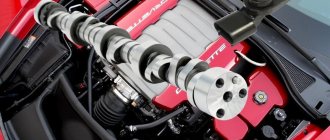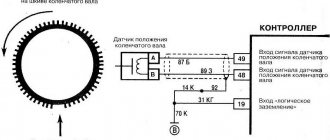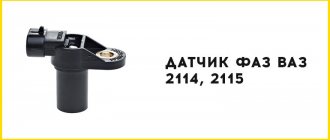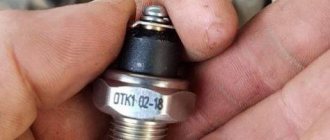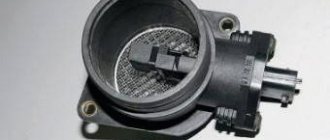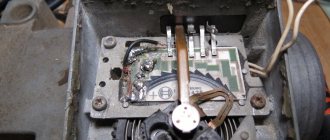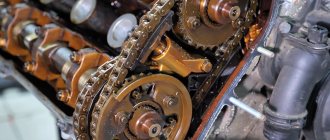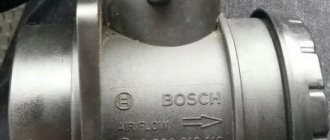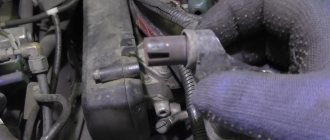Checking the camshaft sensor (abbr. DPRV) allows you to verify its performance and make sure that in engines with phased (sequential) injection, fuel is supplied in exactly the required sequence. Another name for this device is a phase sensor (it is often used by owners of domestic VAZs). The test can be performed using a multimeter in voltmeter mode and/or an oscilloscope. Even a novice car enthusiast can check the camshaft position sensor.
What is a camshaft sensor
A camshaft sensor is a device that records the angular position of a specified shaft at a specific point in time. The information obtained with its help is transmitted to the electronic engine control unit (ECU), and on its basis this control element issues commands for fuel injection and ignition of the air-fuel mixture in each cylinder at a specific point in time.
The operation of the camshaft position sensor is based on the Hall effect. So, directly on the camshaft there is a metal tooth, which, when the shaft rotates, changes the magnetic field in a nearby sensor. This tooth is called rapper.
The sensor detects a change in the magnetic field, which is converted into a low voltage electrical signal. This signal is sent to the electronic control unit.
In fact, the camshaft position sensor only registers one position, corresponding to the position of the piston of the first cylinder at top dead center. Next, phased fuel injection is performed in the firing sequence of the cylinders. Typically this is a 1-3-4-2 system.
Camshaft position sensors have been installed on engines with split (phased) fuel injection since approximately 2005.
If the camshaft sensor fails (the electronic control unit receives incorrect information from it or does not receive it at all), then it is programmed to switch to emergency mode. It involves the use of pairwise-parallel (group) fuel supply to the engine. This leads to two negative consequences:
- A slight loss of engine power, especially when driving in critical modes (acceleration, driving under load).
- Increase in fuel consumption by approximately 10...20% (depending on engine power, its design features, as well as operating conditions).
As for diesel engines, camshaft position sensors are designed similarly, but there is one difference. It lies in the fact that the sensor records the position of not only the first cylinder, but all of them. This is done due to the fact that the drive disk has a separate tooth for each cylinder.
Thus, if a sensor fails, it makes sense to diagnose it as quickly as possible and, if necessary, replace it.
Reading the signal
The signal is a current pulse that is understandable to the control unit. However, the ECU records two states: it is there or not. It is to generate an impulse that a camshaft sensor is installed on the VAZ-2114. The microcontroller processes the pulse and compares it with all the data that was received from other similar devices. Next, a kind of three-dimensional graph is constructed, which is superimposed on the fuel map. In case of a discrepancy, certain ignition or injection parameters are adjusted.
Of course, the graph is built only inside the controller, and it can only be visualized if you connect the control unit to diagnostic equipment. The adjustment occurs constantly while the engine is running. It is worth paying attention to the fact that carburetor engines were not equipped with such devices. The first VAZ-2114 cars did not have a camshaft sensor installed, just like their predecessors, the VAZ-2109.
Signs of DPRV failure
There are several typical signs that indicate that the camshaft position sensor has failed. It is immediately necessary to clarify that the symptoms listed below may indicate completely different malfunctions. Therefore, it makes sense to perform additional diagnostics. So, signs of a DPRV breakdown:
- Problems with starting the engine, under any conditions - “cold”, “hot” and in other modes. This usually results in having to crank the starter longer.
- Unstable engine operation, “floating” operating and idle engine speeds.
- “Dips” in the movement of the car; when you press the accelerator pedal, it does not respond immediately, the dynamic characteristics of the car are lost (it accelerates poorly, does not pull, especially when loaded and when moving uphill).
- When the accelerator pedal is released, the engine stalls.
- Increased fuel consumption (by 10...20%).
- The Check Engine warning light on the instrument panel activates. It is necessary to perform additional diagnostics using an electronic scanner (for example, an ELM 327 device or its equivalent). In this case, typical errors regarding the operation of the sensor are numbers P0340, P0342, P0343.
In fact, the camshaft position sensor is a fairly simple and reliable device, so it rarely fails. More often, its wiring is damaged - the wires fray, the insulation on them is damaged, the so-called “chip”, the place where the sensor is connected to the car circuit, fails.
However, for cars that run on gasoline, the problems described above are not so clearly expressed. But a failed camshaft position sensor will cause many problems for owners of cars equipped with gas equipment, in particular the fourth generation. The malfunctions and problems described above can appear on such machines “in all their glory.” Therefore, owners of cars equipped with HBO are strongly recommended to diagnose and replace the sensor as quickly as possible if it is suspected of being faulty.
Visual inspection
As a rule, in most cases, a visual inspection of the VAZ-2114 car is enough. You can even check the camshaft sensor this way. Many drivers do not look under the hood, so wires often break, the device body is destroyed, etc. Before starting repairs, make sure that the breakdown is fatal and only replacement is necessary. This work takes place in several stages:
- First of all, inspect the phase sensor. Look for mechanical damage on it. If there are cracks or chips, change the device immediately.
- Inspect the contacts used to make the connection. If there is rust or moisture on them, remove it. Check functionality. Very often the cause of poor performance is lack of contact or moisture on the plugs. The same goes for oxidation.
- Check the wiring for breaks and shorts.
Location of the DPRV on the engine
To check the camshaft position sensor, you need to know where it is located. As a rule, on eight-valve engines the DPRV is usually mounted at the end of the cylinder head. On sixteen-valve engines it is also mounted on the cylinder head, usually in close proximity to the first cylinder.
As for popular domestic VAZ cars, their owners call such units phase sensors. Their location in these motors is similar. So, on eight-valve engines, the sensor is located on the left side of the cylinder head (when viewed in the direction of travel of the car).
On sixteen-valve engines - on the right front part of the engine. In the latter case, the sensor is not directly visible visually; its location can only be assessed by the signal and power wires suitable for it. The VAZ 2114 phase sensor is fixed in close proximity to the air filter, near the cylinder head.
Errors DPRV VAZ-2114-2113-2115 for M73 EURO-3 controller
| Error number | Error interpretation |
| P0342 | Phase sensor line, low pulse level |
| P0343 | Camshaft sensor chain, large signal value |
| P0346 | Series of DPRV, pulse output beyond the permissible size |
Error P0342 is recorded when:
- the crankshaft rotates;
- There is a constant low pulse level at the ECU input (terminal “79”).
The malfunction indicator light flashes on the 3rd drive cycle after the malfunction error is indicated.
Temporary damage can be created by the presence of the following deficiencies:
- Not a strong connection between the terminals of the harness strips of the ignition structure, sensor and ECU. Check the connectors of the sensor and controller, the harness strips for strength of connection, the absence of damage to the pad locks and damaged terminals.
- Destruction of the tourniquet. Check the harness for any damage.
Replace the broken camshaft sensor with a working one and try for secondary error formation.
Error P0343 is recorded when:
- the crankshaft rotates;
- There is a constant high pulse level at the ECU input (terminal “79”).
The damage warning light comes on on the 3rd drive cycle after the damage code repeats.
Non-permanent damage can be caused by the presence of the following defects:
- Poor fastening of the contact strips of the ignition structure harness, sensor and computer. Check the connectors of the sensor and the ECU, the cord connectors for the strength of the connections, the absence of damage to the locking bars and broken contacts.
- Harness defect. Inspect the harness for damage.
Replace the damaged camshaft sensor with a known intact one and check for secondary occurrence of the error.
Methods for checking the camshaft sensor
Before testing the sensor using a multimeter or other electronic tools, you must check its mechanical integrity. In particular, it is installed in a housing with an O-ring, ensuring its secure fastening. We need to check its condition.
It would also be useful to check the integrity of the sensor body, whether there are cracks or other damage on it. It is advisable to check the drive disk to see if the teeth are damaged or if there are metal shavings on the sensor body or nearby.
On the Internet you can find information that supposedly the DPRV can be determined to work by simply checking its magnetic properties. In particular, bring a small metal part to its end (the working sensitive part), which should “stick” to the sensor. In fact, this is not the case , and a non-working DPRV may or may not have magnetic properties. Accordingly, verification must be performed using other methods.
There are two main ways to test the camshaft position sensor - using an electronic multimeter and using an oscilloscope. The first method is simpler and faster, but the second is more accurate and provides more diagnostic information.
Checking the camshaft sensor with a multimeter
To check the DPRV, dismantling is necessary. This is not difficult to do; you just need to disconnect the contact group of wires from it and unscrew the fastening bolt. You will also need a small metal object (ferrous metal so that it is magnetic) to test.
Connection diagram for checking phase sensor 21110-3706040.
Connection diagram for checking phase sensor 21120-3706040 The algorithm for checking the sensor with a multimeter is as follows:
- Take a multimeter and switch it to the DC voltage measurement mode in the range up to 20 V (depending on the specific multimeter model).
- Disconnect the “chip” from the sensor by unclipping the latch.
- Remove the sensor from its mounting location.
- On the “chip” of the sensor 21110-3706040 of a VAZ car (and on many others), contact “A” corresponds to ground, contact “C” is the positive wire, comes from the control relay, contact “B” is the signal wire (middle). For sensor chip 21120-3706040, contact “A” corresponds to ground, contact “B” is the positive wire from the control relay, contact “C” is the signal wire.
- Check the presence of power on the chips. To do this, you need to turn on the ignition on the car (but do not start the engine) and do this with a multimeter. If there is no power to the chips, then you need to look for the reason. This could be faulty wiring (insulation damage, broken wires), failure of the control relay, or a glitch in the electronic control system (ECU).
- Next, you need to connect the sensors for testing according to the diagrams shown in the figure.
- Apply a voltage of 13.5±0.5V to the sensor (although less is allowed, for example, 12...12.5 Volts from the battery).
- If, when power is applied to the sensor, the voltmeter detects a lack of voltage on the sensor, then this indicates either a breakdown of the sensor itself, the test can be completed and you can prepare to replace the sensor with a new one.
- Measure the voltage between the positive and signal contacts. It must be equal to at least 90% of the supply voltage (that is, if the supply voltage is 12 Volts, then the voltage at the signal contact must be at least 10.8 Volts).
- Bring a metal object prepared in advance to the end of the sensor (its signal part). Re-measure the voltage at the signal contact. It should be no more than 0.4 Volts. Remove the plate - the voltage value should be restored to 90...100% of the supply. If there are any deviations during the verification process, it means that the sensor has failed and must be replaced.
Please note that it is advisable to check not only sensors already installed on the engine, but also newly purchased ones, since there is always a risk of purchasing a defective product.
An electronic oscilloscope helps to understand how the camshaft position sensor works and whether it produces pulses at all. Usually they use a so-called electronic oscilloscope, that is, simply a simulator program installed on a laptop or other similar device. You need to connect to the camshaft sensor and take an oscillogram from it.
Ideally, there should be a smooth comb diagram with one drop-out peak that corresponds to the rapper passing through the sensor. If the oscillogram has a different shape, additional verification is needed.
When diagnosing the camshaft sensor of Nissan cars (in particular, Nissan Almera) with an oscilloscope, the shape of the oscillogram will be different. It will not be smooth, but in the form of 3 impulses, then a space, then 4 impulses - a space, 2 impulses - a space and one impulse - a space. For engines from this automaker, this feature is the norm.
Causes of malfunction
The main reason for the malfunction of the phase sensor is its natural wear, which occurs over time for any part. In particular, due to exposure to high temperatures from the engine and constant vibration in the sensor housing, its contacts are damaged, the permanent magnet may demagnetize, and the housing itself may be damaged.
Another main cause is problems with the sensor wiring. In particular, the power/signal wires may be broken, which is why no supply voltage is supplied to the phase sensor, or a signal does not come from it via the signal wire. It is also possible for the mechanical fastening on the “chip” (the so-called “ear”) to break. Less often, a fuse that is responsible, among other things, for powering the phase sensor may fail (for each specific car it will depend on the complete electrical circuit of the car).
Replacing the camshaft position sensor
If during the inspection it turns out that the camshaft position sensor itself has failed, then it must be replaced. As a rule, these units are non-repairable, since their body is sealed and cannot be disassembled. The sensor is inexpensive, and the replacement procedure is simple, and even a novice car enthusiast can handle it.
The sensor replacement algorithm is as follows:
- With the engine not running, disconnect the negative terminal from the battery.
- Disconnect the “chip” from the camshaft position sensor (as when checking).
- Depending on the vehicle model, it is necessary to remove parts that prevent access to the sensor. For example, on modern cars like the Lada Vesta, it is necessary to remove the bracket for auxiliary units.
- Using a wrench, unscrew one or two mounting bolts, depending on the type of fastening. The size of the wrench can be different, usually for VAZs it is a 10 mm wrench.
- After dismantling the mount, you must similarly remove the sensor from its seat.
- Installing a new sensor is performed in reverse order.
- Connect the negative terminal to the battery.
When purchasing a new camshaft position sensor, you need to pay attention to the condition of its O-ring. It is usually sold separately. When changing the sensor, it is advisable to also change the O-ring, since over time it wears out and loses its elasticity. You can use an old ring only in case of emergency, when it is not possible to buy a new one.
Lada 2110 21114 1.6 8V 2007 MT › Logbook › Error P0340 2110 phase sensor DF, DRV
A check was displayed, after connecting the laptop the program showed an error - P0340 for the phase sensor or as it is also called the camshaft sensor. I decided that the sensor had died and replaced it with a Kaluga one purchased on the market. The error went away, I sighed. About a month later, the same situation, again an error in DF. I removed the terminal from it and saw that the positive contact i.e. the middle one has oxidized. I picked up contact cleaning aerosols from the market, treated it, and let it dry for 15 minutes. And since the contacts themselves were already approaching, I decided to press them a little with a screwdriver, somehow it was possible... but not of good quality due to the design of the contact itself. I put the sensor back and decided to observe. I started it, drove about 50 meters, the check light came on, I think everything is repeating itself again, after driving a little more, the car warmed up to operating temperature and the error disappeared, I think miracles! After traveling for a couple of days, the situation is the same. I think DF has given a long life again. I bought a new sensor, again from Kaluga, but in a different market. I installed it, the error went away, but I think I found the problem, as a version - in the oxidized contact, because of this, the sensor died, and the error went away after the engine warmed up, because along with the warming up, both the sensor and the contact warmed up. After riding for three weeks this time, this error came to me again
